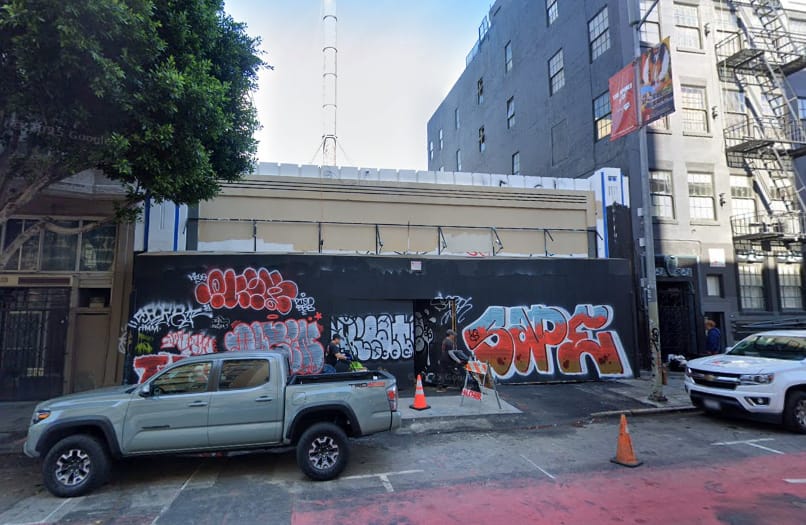
Seeming to fulfill his promise of opening a new shelter, Mayor Daniel Lurie announced plans for a “stabilization center” at 822 Geary. The center, part of Lurie’s Fentanyl Emergency Ordinance, is already drawing praise from Tenderloin safety advocates. It also received strong support from controversial D-6 Supervisor Matt Dorsey. With limited capacity and the dubious “police-friendly” element, could Lurie’s stabilization center do more harm than good?
A drop in the bucket
Not long ago, Mayor Lurie pledged 1,500 new shelter beds in his plan to end homelessness in San Francisco. The tall order, part of an initiative he called “Home Run,” also promised “2,500 units of interim bridge housing.” The mayor did not clarify whether 822 Geary represents Home Run’s inaugural step and neither have any major news outlets. If this stabilization center is in fact part of the plan, it’s a small start. With no apparent maximum stay (90 days? A week? 24 hours?), 822 Geary will offer only 16 shelter beds.
Roughly 4,200 people are living on San Francisco’s streets at the moment. An additional 4,000 people consistently keep the city’s shelters full. If 822 Geary can process 25 patients per day, it will take almost six months to treat 4,200 patients. It’s a drop in the bucket at best. Simply put, Lurie needs to do more.
What does “police-friendly” mean?
The police aspect of Mayor Lurie’s announcement is what worries me. “The 24/7 police-friendly stabilization center will be a critical resource, providing immediate medical and psychiatric care to those in crisis and easing the pressure on our hospital emergency departments and first responders.” (CBS) As an editor, it looks to me like he buried the lede under two leaves and some twigs. Neither Lurie’s Home Run proposal nor any media coverage about his possibly related stabilization center elaborates on Lurie’s police-friendly claim.
I won’t suggest 822 Geary should operate unguarded. However, one should not underestimate the rapidly destabilizing effects that heavy police presence can have on people experiencing a mental health episode. Throughout my life I have watched bad situations get worse because the cops showed up. It’s the badge, the gun, the nightstick, the cuffs, jail, prison, violence, death. It is the worst possible portent and it radiates off their uniform.
Then there’s what certain cops will do to homeless people. In 2023, SF Standard ran a story on how SFPD used excessive force on them “more than 1,300 times in 5 years.” Pairing the police and the homeless feels like asking wolves to guard sheep. To those saying “Not all cops,” I say, “Not even one”. In 1992, my father’s best friend from high school-turned-town sheriff kicked in our front door with four other officers, guns drawn, to bust my father’s weed growing op. I watched the whole thing, until one of them tossed me in my parents’ room and slammed the door. It’s almost ironic how cops can make people homeless, then punish them further.
The stabilization center may be a step in the right direction, but an infamously maligned SFPD’s involvement could be why he falters.
What can Lurie do better?
Firstly, I hope our new mayor seriously considers the delicate nature of treating people suffering a mental health crisis. “Arrest now and ask questions later” is a last resort that became the first move. What I admire most about this initiative is its attempt to remodel the emergency response to those crises. 822 Geary can act as a safety net to keep people from unnecessarily ending up in jail or worse. That is why we desperately need more of these stabilization centers. If ordinary San Franciscans struggle to get by, picture suffering constant exposure to cold and fog amid a psychotic episode.
Drug abuse and deteriorating mental health are two sides of the same coin. It’s why centers like 822 Geary are just the beginning. San Francisco has no time to lose. Adding even three more stabilization centers with the same capacity could reduce that six-month timeline to six weeks.
The upside to Mayor Lurie’s recent fentanyl emergency declaration is that it expedites approval, acquisition and construction of more shelters. A positive though not a promise. Lurie’s next step should be significantly bigger. With 16 out of 1,500 down, he still has 1,484 to go.
The post Mayor Lurie to Establish “Police-Friendly” Stabilization Center at 822 Geary appeared first on Broke-Ass Stuart's Website.









